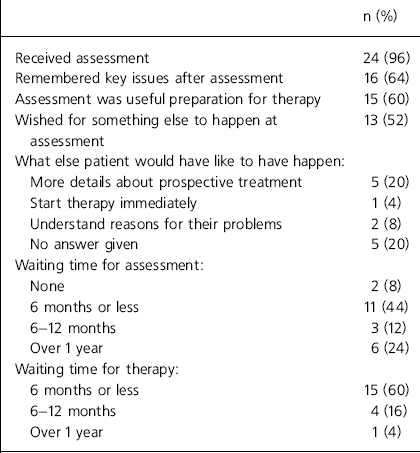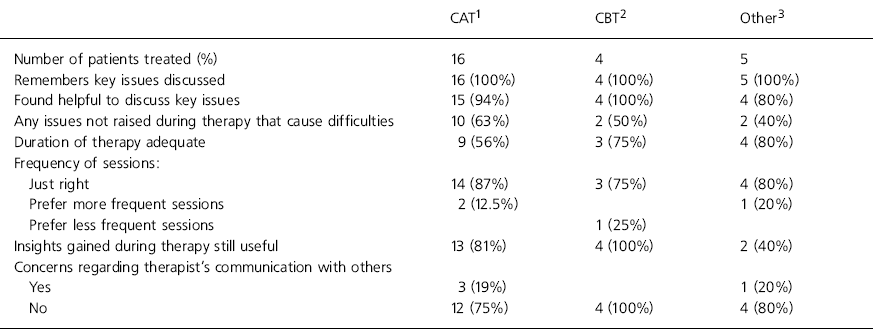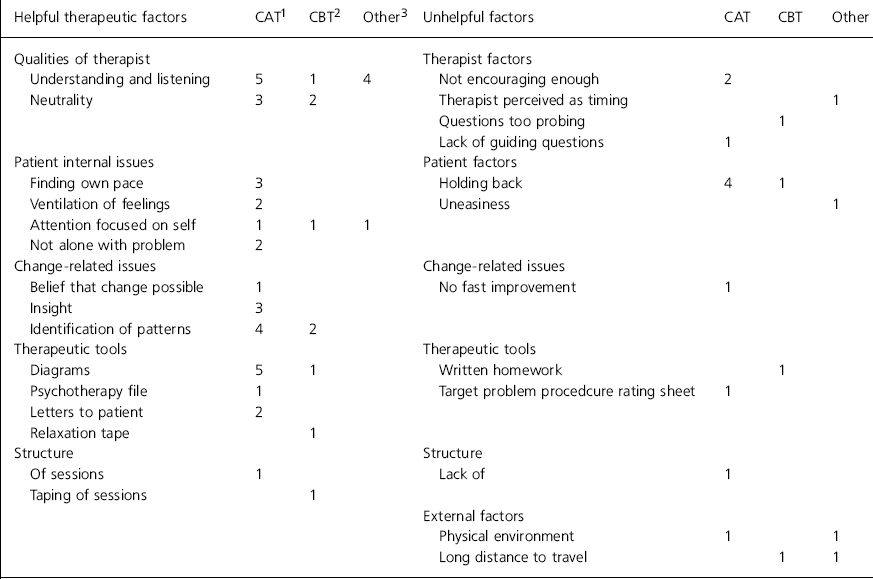Higher specialist training in psychotherapy requires a minimum of 3 years in different therapeutic modalities, one of which is the main modality. Mixing therapeutic approaches during training can be confusing and deskilling (Reference Monaghan and MooreyMonaghan & Moorey, 1999), leading to uncertainty regarding one's own style as a therapist. Treatment outcome is not strongly related to therapists' theoretical orientation (Reference Beutler, Machado, Allstetter Neufeld, Bergin and GarfieldBeutler et al, 1994), but according to some studies it seems more closely associated with the identity of the therapist (Reference Chrits-Christoph and MintzChrits-Christoph & Mintz, 1991). This places importance on finding and evaluating one's own therapeutic style, an issue with which many trainees struggle throughout training. Mostly, this is not addressed during higher training despite regular performance assessments because these do not include formal qualitative evaluations of the process of therapy. Similarly, follow-up data obtained from patients often do not include qualitative data or patients' views on the therapeutic process. Questions about our own patients' experience of us as therapists became important towards the end of training. This article sets out to discuss this in relation to patients' views on completed therapy with two senior registrars in psychotherapy.
Methods
A questionnaire (available from the authors upon request) was devised to combine outcome evaluation with a process of engaging patients in thinking about their therapy. This approach is congruent with the theory of cognitive analytic therapy (CAT) and cognitive- behavioural therapy (CBT), our main training modalities.
The questionnaire covered referral, assessment, therapy and outcome, and was sent to 29 patients who had received a course of therapy with either of two senior registrars in psychotherapy during higher specialist training. Patients could choose to identify themselves by name on their reply. Because this was a naturalistic survey, patients had a variety of difficulties and received different kinds and lengths of therapy. Patients seen only for brief assessments were excluded, but premature terminators were included because their views were of interest. A reminder questionnaire was sent to non-responders.
Results
Twenty-five out of 29 (86%) replied, 23 identifying themselves by name. Of the four non-responders, one was untraceable and three (75%) had revealed a passive aggressive interpersonal style during therapy, two of these had failed to attend for follow-up, one had dropped out of treatment. All but one patient had been assessed prior to commencement of therapy. For issues regarding assessment, refer to Table 1. Sixteen patients had received a course of CAT therapy but other therapeutic modalities were also represented (group analysis, CBT, family therapy, long term psychodynamic therapy and extended assessment). The average period between the end of therapy and completing the questionnaire was 13.1 months (range: 0.5-24). All but one of the respondents (96%) found the experience of therapy valuable. All recalled specific issues discussed and 76% (19/25) felt insights gained were still useful to them. Refer to Table 2 for full results of issues recalled from therapy and patients satisfaction with therapy.
Table 1. Issues regarding assessment

| n (%) | |
|---|---|
| Received assessment | 24 (96) |
| Remembered key issues after assessment | 16 (64) |
| Assessment was useful preparation for therapy | 15 (60) |
| Wished for something else to happen at assessment | 13 (52) |
| What else patient would have like to have happen: | |
| More details about prospective treatment | 5 (20) |
| Start therapy immediately | 1 (4) |
| Understand reasons for their problems | 2 (8) |
| No answer given | 5 (20) |
| Waiting time for assessment: | |
| None | 2 (8) |
| 6 months or less | 11 (44) |
| 6-12 months | 3 (12) |
| Over 1 year | 6 (24) |
| Waiting time for therapy: | |
| 6 months or less | 15 (60) |
| 6-12 months | 4 (16) |
| Over 1 year | 1 (4) |
Table 2. Issues recalled from therapy and satisfaction

| CAT1 | CBT2 | Other3 | |
|---|---|---|---|
| Number of patients treated (%) | 16 | 4 | 5 |
| Remembers key issues discussed | 16 (100%) | 4 (100%) | 5 (100%) |
| Found helpful to discuss key issues | 15 (94%) | 4 (100%) | 4 (80%) |
| Any issues not raised during therapy that cause difficulties | 10 (63%) | 2 (50%) | 2 (40%) |
| Duration of therapy adequate | 9 (56%) | 3 (75%) | 4 (80%) |
| Frequency of sessions: | |||
| Just right | 14 (87%) | 3 (75%) | 4 (80%) |
| Prefer more frequent sessions | 2 (12.5%) | 1 (20%) | |
| Prefer less frequent sessions | 1 (25%) | ||
| Insights gained during therapy still useful | 13 (81%) | 4 (100%) | 2 (40%) |
| Concerns regarding therapist's communication with others | |||
| Yes | 3 (19%) | 1 (20%) | |
| No | 12 (75%) | 4 (100%) | 4 (80%) |
What issues did respondents identify?
Seventy-two per cent (18/25) reflected on the therapist's style and two suggested improvements or changes (e.g. the therapist become more encouraging). Many reported generic qualities in the therapeutic relationship, such as an ‘understanding presence’, as being the most helpful factors. (For a full breakdown of issues identified as helpful or unhelpful to the patients, refer to Table 3.) Of the 16 patients who had received CAT, three volunteered that they found the sequential diagrammatic reformulation useful, one recorded the psychotherapy file as beneficial and two found the letters to them helpful. One found the target problem procedure rating sheet unhelfpul.
Table 3. Helpful and unhelpful factors identified by respondents

| Helpful therapeutic factors | CAT1 | CBT2 | Other3 | Unhelpful factors | CAT | CBT | Other |
|---|---|---|---|---|---|---|---|
| Qualities of therapist | Therapist factors | ||||||
| Understanding and listening | 5 | 1 | 4 | Not encouraging enough | 2 | ||
| Neutrality | 3 | 2 | Therapist perceived as timing | 1 | |||
| Questions too probing | 1 | ||||||
| Lack of guiding questions | 1 | ||||||
| Patient internal issues | Patient factors | ||||||
| Finding own pace | 3 | Holding back | 4 | 1 | |||
| Ventilation of feelings | 2 | Uneasiness | 1 | ||||
| Attention focused on self | 1 | 1 | 1 | ||||
| Not alone with problem | 2 | ||||||
| Change-related issues | Change-related issues | ||||||
| Belief that change possible | 1 | No fast improvement | 1 | ||||
| Insight | 3 | ||||||
| Identification of patterns | 4 | 2 | |||||
| Therapeutic tools | Therapeutic tools | ||||||
| Diagrams | 5 | 1 | Written homework | 1 | |||
| Psychotherapy file | 1 | Target problem procedcure rating sheet | 1 | ||||
| Letters to patient | 2 | ||||||
| Relaxation tape | 1 | ||||||
| Structure | Structure | ||||||
| Of sessions | 1 | Lack of | 1 | ||||
| Taping of sessions | 1 | ||||||
| External factors | |||||||
| Physical environment | 1 | 1 | |||||
| Long distance to travel | 1 | 1 |
None attempted to re-open therapy and eight respondents claimed that certain insights were still ‘coming to light’. Of the 25 patients, five CAT patients would have liked to receive longer treatment. Four CAT and one CBT patients misinterpreted this question and stated they would have preferred longer sessions because they were just opening up when sessions ended. One other patient felt ‘timed’ by the therapist.
Twenty per cent (5/25) suggested we make changes to the service. Of these, three patients stated they would like the waiting time for treatment to be reduced, one felt uncomfortable completing forms in the waiting room and one asked for assessors not to give negative messages about concurrent use of medication. Although not directly enquired about, no patient indicated a wish for alternative child care to be made available during therapy, despite this having been a realistic obstacle for engagement in treatment for some mothers. This may reflect the low expectation of NHS patients to take such practical issues into consideration.
Discussion
What did we learn from the patients' responses? Our experience
This was the first time that we directly received a structured feedback from patients and our anxiety on reading the returned questionnaires may have resembled our patients' experience on attending therapy, almost a reversal of roles. This attuned us to issues identified by respondents, such as therapy inducing shame. In the light of increasing patient demand for ‘talking therapies’, this is an interesting issue and may be linked to patients' reluctance to ask for support in accessing the department or for child care arrangements. Although seven patients had not seemed to make large-scale improvements, three of those indicated that changes had occurred and were ongoing, which means that goals for therapy need to be tailored individually. Prediction of good outcome is difficult and can easily lead to premature discouragement if goals are set unrealistically, or imposed on patients. The message to therapists is not to give up hope, which may be one of the important ingredients in a therapeutic relationship.
We felt that a thorough assessment of ‘customer-ship’ at the outset is vital and patients should not be offered therapy without such assessment. One patient who had been prioritised and taken into parent/infant therapy without assessment subsequently expressed the most negative experience. The negative transference in this therapy was useful learning for the trainee.
This means that at the assessment stage patients' motivation and expectation need to be tested with a realistic possibility of refusing requests for therapy. This can lead into a focused work around motivation, rather than on the initial presenting problems. Understanding why change is so difficult can be a legitimate therapeutic goal in its own right and lead to different patterns of engagement with other services and professionals.
On a more personal note, we learned how difficult it is to establish a collaborative therapeutic relationship with patients with passive aggressive personality styles that, although an issue during therapy, became more apparent once they defaulted from follow-up and failed to participate in the survey. Being more alert to this pattern at the outset is important.
Refusing patients can seem counter to the ‘caring’ notion of the NHS and our own personal caring agenda. This survey challenged our assumption that offering less frequent sessions was experienced automatically as somehow withholding. Although three of the surveyed patients expressed wishes for more frequent meetings, there was also a psychotic patient who found weekly contact too intense and preferred less frequent sessions. Hence, a model of future working practice may be to negotiate more flexible individual contracts, perhaps with more follow-up sessions spread out over longer periods. In our study one person, who returned their questionnaire having dropped out of therapy before agreed termination, not surprisingly expressed more critical attitudes towards therapy. In retrospect, an enquiry about reasons for missing follow-up appointments would have been useful for this survey.
Fathoming out what sort of therapeutic model suits the therapist is akin to the process of defining postgraduate specialisation for newly qualified doctors. The discovery can only be made by the practice of different models, followed by an assessment of how the model fits with the therapist's temperament and repertoire of interpersonal skills. Training therapy plays a role in expanding this sort of awareness, so that trainees become better adept at managing their own counter-transference. This survey as a way of ‘learning from the patient’ (a structured qualitative enquiry) can take on a complementary role to training therapy.
As in most training, adherence to pure therapy modalities and fulfilment of training requirements can become an overriding concern and restrict therapeutic expression and spontaneity. Insight into how patients perceive us can help to rediscover spontaneity and authenticity, permitting the expression of our own personalities (with awareness and reflection) in the therapeutic relationship without fear that this must be damaging. Our patients helped us to be more aware of how anxiety provoking and potentially persecutory unstructured reflection can be. In the process of our training and with help of this survey we learned the importance of trying to achieve an optimal balance between challenge and support.
Implications for the service
A number of issues for a potential overhaul of routine practice were raised by our survey. The long waiting list was frequently commented upon.
More readily changeable are concerns regarding intra-departmental practices. Patients indicated a dislike of completing questionnaires in the semi-public waiting room, so this has been modified. Patients also suggested that information about therapies should be available at the assessment stage and that the time between assessment and the start of therapy could be used in preparation for therapy. We suggest that the department produces information leaflets about various therapies on offer, as suggested by Roth and Fonagy (Reference Roth and Fonagy1996). This could include a list of recommended reading such as self-help books.
Particularly for CBT or CAT, patients could be prepared for ‘therapeutic self-observation’ by the use of diaries at the assessment stage and continue this while awaiting therapy. This could make waiting times therapeutic, enhance future participation in therapy and even lead to potential shortening of treatment.
Some assessing therapists had - misguidedly - put patients off taking psychotropic medication during the time in therapy. Antidepressants are not contraindicated for psychotherapy and other drugs can be worked with therapeutically unless they impair patients' participation in treatment (Reference Roth and FonagyRoth & Fonagy, 1996). This should be conveyed to therapists and patients.
Conclusion
There is a tendency in psychotherapy, as well as in medicine, to use randomised controlled trials as the gold standard method of assessing treatment. This has been criticised by Seligman (Reference Seligman1995) on the grounds that randomised controlled trials do not resemble ‘normal’ working practice. Seligman suggests the evaluation of therapies should move towards greater use of effectiveness studies. He has used a prospective ‘consumer report’ model on the grounds that this reaches a large proportion of the population and results in a less-biased sample. Consumer surveys establish effectiveness of actual treatments by asking patients directly, and take into account therapeutic input received from a variety of sources over time.
We did not undertake a prospective approach, which means that our results show us more the kind of therapists we are now. We deliberately devised a questionnaire that would reflect treatment received and could potentially be used as an extended therapeutic tool in that, by responding, patients were reminded of issues covered in therapy. At the same time, it asked patients to adopt a therapeutic stance of self-observation, in our opinion an important ingredient of any therapy. We have tried to ‘take our own medicine’ in attempting to observe ourselves as therapists by asking our patients' views in a simple, direct approach.
Inherent in consumer satisfaction surveys are transference issues such as attempts to please therapists or fear that expression of negative attitudes may prejudice further therapy. A concern, which we had at the outset of this survey, that asking patients' views about their treatment may result in increased requests for more treatment, even if on entirely appropriate grounds, was not substantiated.
Finding out from patients about us as therapists through direct enquiry is one way among others that helps shape our therapeutic style and choice of predominant therapeutic modality. We would recommend that a similar approach be used prospectively for evaluation of training. This would then show trainees how their therapeutic style is developing in relation to patient outcome over time.
Acknowledgements
We acknowledge P. Casement's work: On learning from the patient (1985), Routledge, London. We would like to thank the two anonymous referees for their helpful comments.






eLetters
No eLetters have been published for this article.